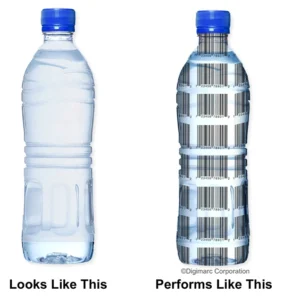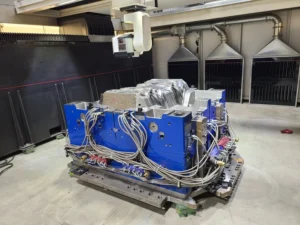
By Chad Hase, director of advanced manufacturing, Custom Etch Inc.
Five-axis laser machining makes digital mold textures possible for all moldmaking processes.
Mold manufacturers using laser technology can play a vital role in brand protection, recyclability and traceability efforts with new digital mold textures.
Laser texturing has opened the door to new possibilities in design, engineering and moldmaking with the development and implementation of five-axis laser machining.
Evolution

The first evolution of laser technology focused on cosmetic texture applications that yielded unprecedented geometric and homogeneous patterns for products across the automotive, aerospace, consumer products, defense and medical industries. These engineered patterns demand full five-axis laser CNC machining, as they are impossible to achieve with traditional chemical etching.
The second evolution involved the development and incorporation of functional textures. This application gives products a physical property while maintaining the cosmetic appearance required. For example, adding a gripping effect to ease handling for touch or grab products or promoting a new surgical procedure to help bone growth on implants. Laser texturing has no limitation on design because it is a 100% digital process.
The new evolution of today is digital watermarking. This application places a unique digital code within a texture, completely hidden to the naked eye but fully readable by machine vision systems, including smartphones. This embedded digital watermark is applied directly into textures and creates an invisible code that is the size of a postage stamp. This process only can be done using laser technology.
Three Reasons to Use Digital Watermarking Textures
Here are three benefits of digital watermarking textures:
1. Brand Protection
- Counterfeiting impacts trade, jobs and brand reputation, making anti-counterfeit solutions attractive. For example, a laser digital watermark texture ensures product authenticity and aids in identifying knockoffs.
- A strategically placed digital texture offers digital tracking that can improve brand safety and anti-counterfeiting measures critical to regulatory compliance in the medical and pharmaceutical markets.
- Most products have no digital presence, making their lifecycle unknown. Laser digital watermarks confirm data effortlessly with digital authentication and analysis.

2. Recyclability
- Digital textures act as a digital passport for a circular economy and show consumers a company’s alignment with sustainability initiatives.
- Digital textures offer label-less design, making it easier to recycle.
- Digital textures are a solution for the regulatory scrutiny and consumer sentiment that dictates manufacturers’ responsibilities to manage plastic waste better. An example is the packaging industry’s ‟Holy Grail 2.0” initiative, which involves more than 170 companies and organizations in Europe, focused on using digital watermarks to improve sorting accuracy.
- Digital textures deliver data about packaging attributes, such as reusable post-consumer recycled (PCR) material.
3. Traceability
- Digital textures play a vital role in Industry 4.0 by delivering product digitization that illuminates more about the manufacturing process and business. This digitally scanned data eliminates manual documentation and human error of vital product information; for example, tracking product transportation.
- Digital textures digitally structure and streamline regulatory compliance (FDA, OSHA, ISO, etc.).
- Digital watermarks identify the manufacturer, resin type, color, weight, use, recyclable vs. non-recyclable, monolayer vs. multi-layer packaging, carbon-black, opaque, difficult-to-recycle packages and new material introductions (PCR vs. virgin).
Additional facts about digital textures
Unlike a static QR code, digital textures are dynamic and point to a new source of information at any given time – making them 100% customizable.
Information via internal and external data retrieval means that product intelligence can be sent for deeper business insights on a product’s complete lifecycle, better brand integrity, accuracy, efficiency, security and supply chain traceability.
Laser texturing is widely accepted in today’s manufacturing process, as it offers product improvement and higher quality. Laser digital textures give mold builders a new, innovative solution to meet customer needs and open the door to new business opportunities across all end markets.
Chad Hase is director of advanced manufacturing at Custom Etch Inc., a design company based in New Castle, Pennsylvania. He has over 25 years of experience in tool and die manufacturing and has been instrumental in bringing new laser technologies to North America. Hase’s current research involves the study of digital watermarks and continued studies on surface treatment from different laser sources on medical and aerospace materials and microstructures. Since 1982, Custom Etch has provided its customers with experienced support to develop their texture ideas and expertise to create the best possible aesthetic and functional textured surfaces.
More information: www.custometch.com


